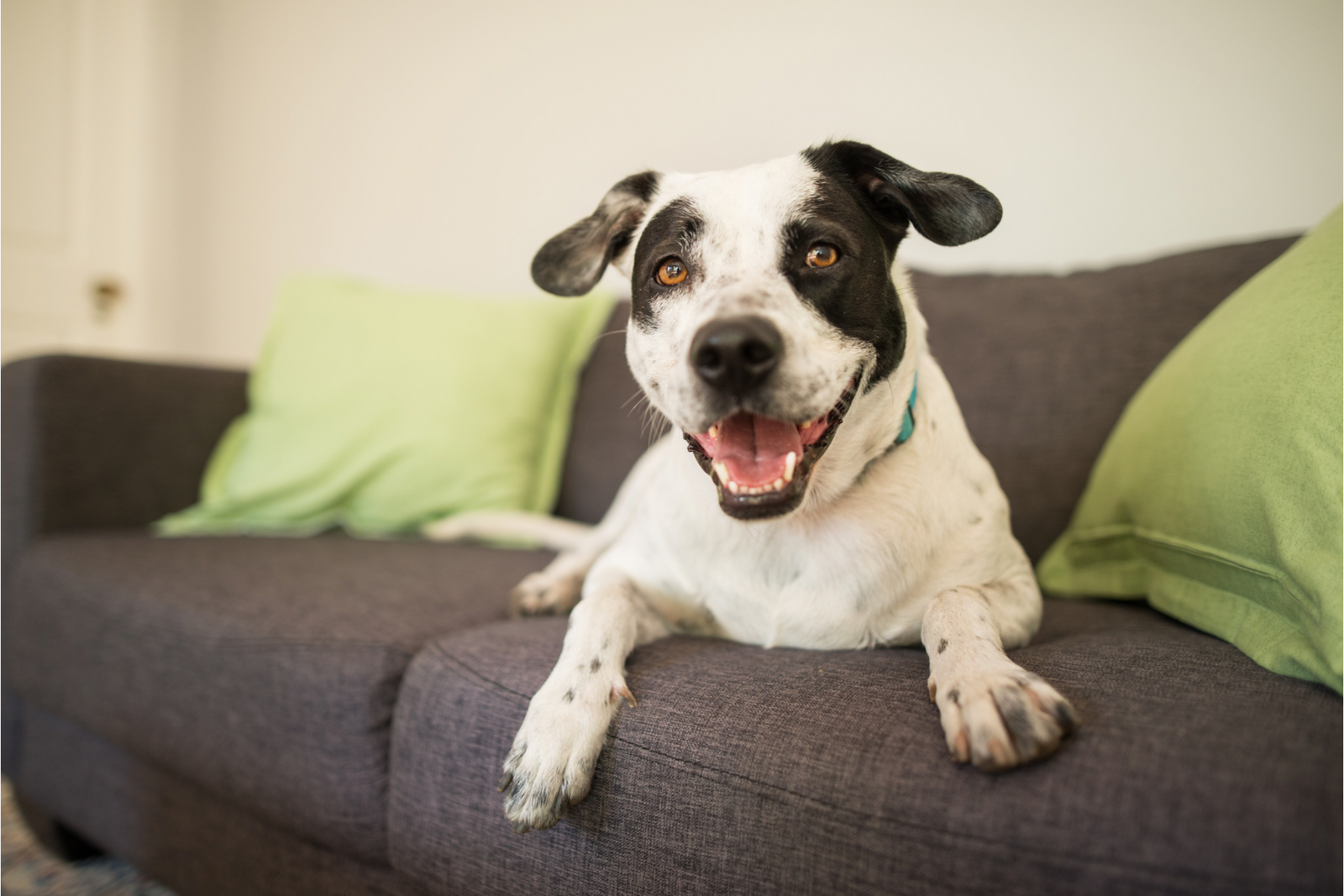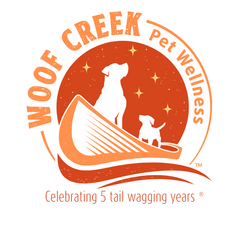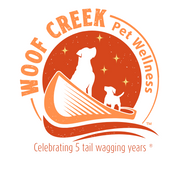Understanding and Managing Your Dog’s Anxiety

At A Glance:
Signs your pup may be struggling with anxietyCommon triggers and stressors for dogsTips and tricks for managing canine anxietyResources for pawrents with anxious pupsHow dog’s respond to our stress
Scroll down for 3-minute read
Canine anxiety is something that many dog parents deal with in one way or another. Whether it be triggered by common sources like thunderstorms and fireworks, separation anxiety, rescue/rehome history, or something that is constantly present, many pet owners will deal with one or more types of anxiety within their dog’s lifetime. Like with humans, anxiety is a normal emotion for dogs to experience from time to time, but for some dogs and their owners, it can become a persistent source of discomfort and frustration.
So, how can you tell if your pup is anxious,and what can be done?
Stress/anxiety can present itself in many ways within dogs. Increased vocalization, extreme alertness, skittishness, restlessness, destructive behaviors and changes in mood; These are all behaviors of a guarded dog, and anxiety tends to cause our dogs to act more guarded, as they’re typically on alert for the next trigger and constantly expecting something negative to happen.
Generally, anxiety within dogs will have one of a few causes. Pain or fear, aging, and separation are the most common reasons your dog may exhibit signs of anxiousness. Identifying the cause for anxiety within your dog will play a large role in consoling them.
With pain or fear, you may notice a direct cause and effect when it comes to your dog’s anxiety. Take loud noises, as an example. Imagine a thunderstorm has just rolled in. There’s thunder cracking every few seconds and your dog, who was behaving normally previously, is now hiding with ears and tail tucked. Or perhaps they’re panting and pacing, restless and unable to settle. Loud noises like thunder and fireworks are very often the cause of stress within dogs, and in the case of both of these triggers, dogs are also sensitive to the atmospheric pressure and static electricity, both of which are uncomfortable and disorienting for our furry family members Dr. Dodman, an animal behaviorist with the Center for Canine Behaviors, shared with NBC2 that dogs may sense storms through the static electricity in their bodies, calling it the Static Electricity Theory of Dog Phobia.
Pet parents have reported various ways that they have been able to keep their pets physically comfortable during storms, fireworks and other loud noises or stressful situations. Thunder Shirts are designed to apply constant and gentle pressure to your dog, creating a soothing effect to reduce anxiety. The concept is similar to that of a baby swaddle and is meant to make your dog feel more secure in the midst of their anxiety triggers. Some have even seen an increase in comfort for their dogs by switching their comfort areas to ceramic bath tubs or padding a designated area with high-thread count sheets (which yield lower static electricity) and smaller tiled areas for more comfort.
Setting your dogs up for success in these situations is crucial. White noise, music, and soothing sounds are all ways to muffle the sound of thunder or fireworks. There are even YouTube playlists titled “Sounds For Dogs” consisting of thousands of white noise and gentle, often classical, melody tracks to both soothe your dog and gently drown out the noise of stressors. The Animal Behavior Centre at Queen’s University in Belfast found that classical music encouraged dogs to settle and lie down. Keeping your dog occupied by playing games, using snuffle mats or puzzle toys, or practicing commands (with lots of clean treats (link to duck bites) or motivating toys) is also an excellent way to distract from the source of their fear.
If your dog uncharacteristically begins to exhibit signs of anxiety, they may be inadvertently telling you that something is going on. Dogs in pain or discomfort (ie allergies) may start to show signs of stress as their physical state is causing them discomfort, leading to anxiety. We recommend doing a head-to-toe check of your dog at least once a month to take stock of any abnormalities, and as always, pay attention to any behavior that is out of the norm for your pup and act accordingly.
Another common stressor for dogs is separation anxiety. If you’ve ever left the house and made it to the driveway only to hear your dog barking and howling after you, they probably have some level of separation anxiety. A lot of pets with separation anxiety may turn to barking, howling and even destructive behaviors as a result (very destructive behavior signifies true separation anxiety, per McCann Dog Training, and may need professional guidance from a dog trainer or behaviorist.) Your anxious dog may also act as though they haven’t seen you in a long time when you get home, even if it’s only been an hour.
Treating levels of separation anxiety sounds as simple as teaching your dog to tolerate being by themselves, but, in reality, a lot of effort and, most importantly, consistency goes into it. Giving your dog a safe space to be while you’re not present is step #1. Some owners opt for a crate, while others designate a room in the house for their dog to be while alone by blocking/gating off other areas. Whatever you choose, know that dogs are den animals, and having a sense of place and a space that they feel comfortable in goes a long way towards ensuring that they are comfortable. Snuffle mats, clean-food stuffed toys, and treat-dispensing dog cameras like the Furbo and other positive reinforcing distractions can also be helpful.
Another important parental action to take, is to gradually grow your pets’ tolerance to any stressor, like being left alone. This slow acceptance of a trigger is called behavioral shaping, which is an important, confidence building tool for really any triggering stressor. Shaping involves a goal behavior being broken down into micro steps to eventually achieve that end goal. This method of slowly building on skills is wonderful for relationship building and trust between your pet and you, their guardian.
When our furry companions age, it is not uncommon for a them to naturally develop some level of anxiety. With this newfound anxiety can come a host of new behaviors, like excessive licking or biting, uncontrolled urination (even for dogs who are potty trained) and changes in sleep patterns, to name a few. We offer a Senior Saver bundle (link) for pet pawrents whose fur babies have entered their golden years. This bundle is jam packed with wellness essentials that will help increase internal comfort and, therefore, reduce stress in a senior dog, like our Essential Stress + Anxiety Support Meal Topper and Omega-3 Fish Oil.
Ignoring signs of anxiety presented by your dog can result in worsening anxiety overtime, so it’s important to pay attention to the signs your dog is exhibiting that may indicate that they are stressed. But once you’ve identified the signs, what can be done?
Some conventional veterinarians may try to sell you a pill to ‘cure’ your anxious dog. Severe anxiety cases and immediate relief for extremely stressed pups may be needed for their safety and quality of life, but for long term solutions and in most cases, synthetically made chemical medications are only band aids that can really challenge the pup’s overall health and longevity.
Nutrition, proactive management, and training are all integral to handling canine anxiety.
Feeding a healthy, species-appropriate diet is perhaps the first item to address to lower your dog’s levels of stress. When your pup’s gut is unbalanced, their body is stressed. Incorporating proper, clean nutrition and a canine-specific, unprocessed diet will reduce stress by improving their gut health and immune system responses, while reducing inflammation and enhancing their systems overall. Pet Fooled, an Amazon Prime documentary, provides a deeper understanding of the negative impact poor nutrition can have on a dog’s overall health with commentary from prominent, proactive integrative veterinarians.
In addition to cleaner diet considerations, Woof Creek’s Essential Stress + Anxiety Support Meal Topper is an ideal step for pup parents looking for natural relief and overall systemic balance for their anxious fur babies. This whole food topper helps calm and maintain equilibrium for your fur baby, inside and out. It is formulated with clean, selectively sourced superfoods, novel proteins, and medicinal mushrooms to reduce bodily discomfort, oxidative stress, and inflammation while also restoring equilibrium in the endocrine, circulatory and digestive systems. The Stress + Anxiety Support topper is also available as a part of this Anxiety Bundle which contains three wellness essentials geared towards calming and balancing your anxious fur baby, and for a special bundle price!
Consistent training, proactive management, and boundary setting will go a long way towards improving the life of both you and your dog when it comes to separation anxiety (and in general!) This video from McCann Dog Training (link), a trusted source for effective training tips and high quality content, is a wonderful resource for pet parents who are in need of some structure in order to overcome their pup’s separation anxiety. When nutrition, proactive management, and training are practiced in conjunction, you may notice a world of improvement when it comes to your dog’s anxiety and overall well being!
We know dogs are sensitive animals, but it may come as a surprise that our fur babies can actually smell cortisol and pick up on our stress levels, according to findings by Linkoping University zoologist, Lina Roth. Our pup’s understand us deeply and are connected to our emotional states. In fact, the study even shows that dogs can pick up on habits that we have as a result of anxiety, like pacing, for instance.
Another mind-blowing study conducted at the University of Naples in Italy compared the response of dogs to complete strangers after smelling sweat samples of subjects who watched happy movies and those who watched scary movies. The dogs showed signs of happiness and excitedly approached the strangers after smelling the samples of those who had watched happier movies and had adverse and even fearful reactions when the other samples were introduced. According to Planet Paws’ Rodney Habib, the dogs were not only able to detect emotions through scents, but they also adapted to these emotions as a result. While this is true, remember that stress is as normal for us to experience as it is for our canine companions, and there’s no need to worry about stressing your dog out through your own stress. That said, it is, of course, wonderful and symbiotic for parents to work toward stress reduction for their own health; knowing that it will reduce anxiety for their fur family members can be seen as a bonus. Researchers suggest trying to relate to your dog through parents’ similarities and work on strengthening their relationship with their pups, making them comfortable in ways that parents can control is additionally synergistic.
So, for our fur family members’ best lives, we want to manage their internal and external stress levels. We hope the tools and ways offered here will be helpful. Pups and pawrents deserve it!







